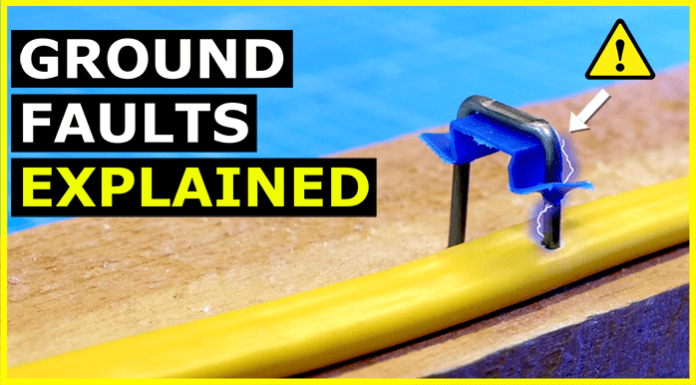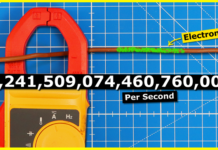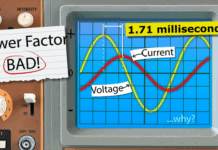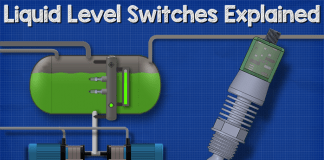Scroll to the bottom to watch the YouTube tutorial.
If this hot wire touches this ground wire, the circuit breaker instantly trips. If the hot touches the neutral, it also trips. But if we place a lamp between the hot and neutral, it doesn’t trip.

When we turn on a light switch, the current flows along one of the two service hot conductors to the property, then down through the electrical meter, then through the main disconnect, and then into the main electrical panel where it connects to one of the hot bus bars. It travels down this bus bar to the circuit breaker and then out along the hot wire to the switch and then to the light fitting. It then travels back along the neutral wire to the neutral bus bar and then back to the main disconnect, back through the meter and over to the transformer. The circuit is complete so the light illuminates.
I have animated this using DC current as it’s easier to visualise, but in reality, we use AC current which moves backwards and forwards like this.
If we measure between the hot and neutral we read around 120V [RMS]. The resistance of the lamp limits the current flowing in the circuit so only a small current flow. This is much less than the rating of the breaker so it won’t trip.

If the hot wire came into contact with the ground wire, there would be almost no resistance, so an extremely large current would instantly flow. This would exceed the limit of the circuit breaker and it will automatically trip to protect the circuit. But, all other circuits in the property should remain energised.
The NEC defines a ground fault as an unintentional connection between the ungrounded conductor and a normally non-current carrying conductor, including enclosures, raceways, equipment or earth.
When the fault occurred, it allowed current to stray from the intended path, and travelled along the normally non-current carrying conductor back to the source, in this case through the ground wire. This is therefore a ground fault and it means we have a serious problem with our circuit.
The NEC defines this as an effective ground-fault current path, because it’s an intentionally constructed path for a fault current to return to source.
Ground faults occur when the hot touches the metal surface of the switch or outlet, or if it touches a metal electrical box. It happens when a nail or screw is driven through the cable and connects the hot and ground wire. Or when liquid enters the electrical box and provides a passage to ground. Or maybe the insulation of the wire in a device has been damaged and current flows through the metal case to ground.
Regardless, if we try to reset the breaker, it will instantly trip again.
If the fault occurs from a plug-in device, we can just unplug this and the breaker should reset. We then need to repair or replace the device.
If the fault occurs from the fixed wiring, we need to check the connections to ensure they are all properly fixed and dry. If that doesn’t solve the problem, we need to work our way along the circuit, disconnecting sections until the breaker allows the reset. We then know the fault must occur somewhere in the disconnected section. We can use the continuity function to confirm if it’s in the fixed wiring Or in the fixture as there should not be continuity between hot and ground.
The reason the breaker trips, is because the wires will increase in temperature anytime current flows through them. This is normal, it happens every time we turn on a device or light. But if the wire become too hot, the insulation will deteriorate, exposing the conductor and potentially causing a fire or an electric shock.

You may have noticed that there is also a path current can take from the ground rod of the main disconnect to the ground rod of the transformer. This path has a much higher resistance or impedance, so it’s far easier for current to take the low impedance path through the service neutral directly back to the transformer.
Current can take this route, but the NEC doesn’t consider this an effective ground fault path.
If we consider a fault where the hot touches the metal case, then the current can flow through the case to reach the ground bus bar and from there it can reach the main bonding jumper in the main disconnect and get back to the transformer. This completes the circuit and allows the breaker to trip. That is why the main boning jumper is so important.

The raceway between the main panel and main disconnect is often PVC, so if the ground wire was disconnected at the main disconnect, the circuit isn’t complete so the breaker won’t trip and all metal parts will become energised. However, if a metal raceway was used, then current could still reach the bonding jumper and complete the circuit.
If the ground wire was connected, but the service neutral was disconnected, then the only path current can take is through the ground rod to reach the transformer. But, because the resistance is so high, the current probably won’t be enough to trip the breaker.
If the neutral bus bar was also bonded in the main panel by mistake, then the ground fault current can travel along the ground wire, it can also travel through the case and then also along the neutral wire and if a metal conduit has been used it will also flow through the conduit. So we have 3 parallel paths for fault current, we don’t want that. That’s why in this particular system, we do not bond in the main panel.
However, older systems without the external main disconnect will be bonded in the main panel. We have covered that in a previous article.
If we consider a fault where an outlet or a switch is in a plastic box and the ground wire has been disconnected. Then when the hot wire touches the metal surface, there is no way to complete the circuit and the metal surface becomes electrified.

If someone touches this they can become part of the circuit and current will flow straight through them and find a route back to the panel. Because the body has a high resistance, a small but potentially fatal current can flow which is might not be enough to the trip the breaker.
Additionally, if the neutral wire was damaged and it came into contact with a grounded surface or ground wire, current can flow along the ground wire back to the panel, but this will not trip the breaker because the load is providing resistance. So the current won’t exceed the limit of the breaker and it will continue as normal.
However, we can use GFCI breakers, outlets and plug in devices, which will prevent most of these faults.
GFCI protection is now required in most parts of the home by the NEC.

The GFCI breaker has this coiled neutral wire built in. The breaker fits into the panel as normal, but the circuit neutral will now connect into the neutral terminal on the breaker, and the pig tail will then connect to the neutral bus bar.
With this design, the current now flows through the breaker on the hot wire, through the circuit and then back into the breaker via the neutral wire, it passes through the breaker and into the neutral bus bar, then back to the source.

Under normal operation, the current on the hot wire should be the same as the current on the neutral wire, so the breaker remains active. But, during a ground fault, some of or all of the current is returning on the ground wire, so the current on the neutral wire is lower than the current on the hot wire. The breaker will realise this and instantly trip, if the threshold is exceeded.
With the breaker version, all parts of the connected circuit are protected and anything you plug into the outlets are also protected. So, an exposed neutral ground fault would trip the breaker. And touching an energised part while grounded should also trip the breaker.
With the GFCI outlets, anything you plug into the device is protected and all the outlets downstream are also protected. But nothing upstream. So, an exposed neutral ground fault after this point would trip the outlet, but if the same fault occurred before the outlet, it wouldn’t offer protection. Touching an energised part while grounded after the outlet should trip the outlet, but not if it happens before the outlet.
Now, a short circuit occurs when the hot and neutral come into contact. There is little to no resistance in these wires, so an extremely large current will instantly flow and trip the breaker.
The NEC defines a short circuit as an abnormal connection of low impedance between two or more points of different potential.

During a short circuit, the current remains within the intended route, it just took a shortcut to get there. If the hot touched the ground wire, this is also a short but current has travelled along a normally non-current carrying conductor, which means it’s a ground fault.
Short circuits can happen if a lamp cord is crushed, creating a path between the two wires. Or if a nail is driven into the cable hitting the hot and neutral wire. Maybe a screwdriver accidently connects across the hot and neutral in the circuit.
However, if a nail is driven into just the hot wire, it won’t trip the breaker. The nail just becomes electrified. The resistance of the nail might cause it to become hot when the circuit is in use. Or it might create an arc.
An electric arc forms when electricity travels through air between two conductors.
When a switch flips or a breaker trips, an arc can briefly form between the contacts as they open. But this isn’t really a fault. An arc fault is unintended.
For example, if a wire is cut or broken, an arc can form between the conductors. If the wire is pulled from a terminal it can also arc. If the terminal on a switch or outlet is loose it can create an arc. If the insulation on a wire is damaged, an arc can form between the conductors.
So we have series arc faults as well as parallel arc faults.
The arc is incredibly hot, it damages metal surfaces, it can even weld them together and it can easily cause a fire. So, the NEC requires AFCI protection to be installed on certain circuits.

AFCI breakers and outlets are used to provide protection. There are different types which are used for different circuits.
But, the device contains a circuit board which monitors for the tell-tale signs of an arc fault occurring and it will then trip if it detects one.
The arc emits light and often a sound as the gas molecules in the air break down, forming a plasma which allows current to flow through the air, it’s also what we use in electronic ignitions.


















